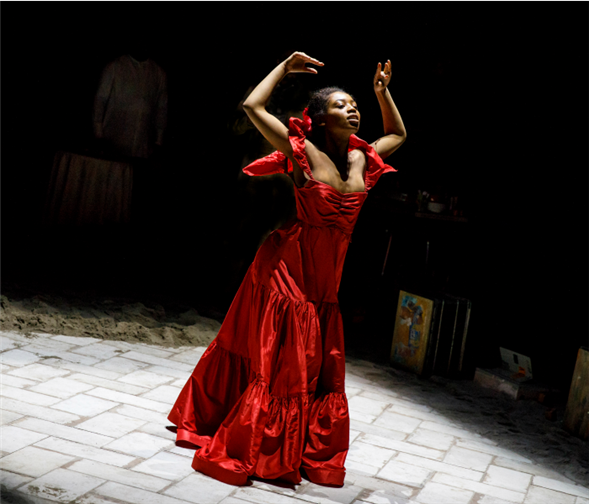Translate Page

Veteran choreographer Camille A. Brown comes to Broadway with Once on This Island
---
Working on the first Broadway revival of a beloved musical can be a challenge -- especially for choreographers. A dance-maker needs to figure out how to realize her own vision while recognizing that another artist previously danced in her shoes. Although choreographer Camille A. Brown is used to creating original pieces with her eponymous dance troupe, she wasn't intimated when Tony-nominated director Michael Arden asked if she would be interested in making her Broadway debut as choreographer for his revival of Once on This Island, currently at Circle in the Square Theatre. In fact, she was intrigued.
Based on Rosa Guy's novel My Love, My Love: or The Peasant Girl, the French Antilles-set musical tells the story of poor island beauty Ti Moune (Hailey Kilgore) who falls for Daniel (Isaac Powell), an aristocrat -- but it's no simple romance. Ti Moune's journey is infused with magical realism, calypso-inflected songs by Stephen Flaherty and Lynn Ahrens, and conflicts of class and colorism.
Since much of Brown's work is highly narrative and frequently fuses social dance, technical prowess, and black identity, the show seemed like an excellent fit for her artistry. "I wanted to ensure authenticity, as I always do," she says. "How can I be true to the culture and also my voice within it? How do I create something that honors the story and how I look at the story?"
{Image1}
Brown never saw the original Broadway production and only watched one YouTube video of the cast performing on the 1991 Tony Awards. Instead, she threw herself into cultural research. "I connected with [Haitian-American dancer and choreographer] Maxine Montilus, and I've also had African dance training at the Bernice Johnson Cultural Arts Center and DeVore Dance Center," Brown says. "There are names of African and Afro-Caribbean dances that we focused on including Djouba, Contredanse, and Rabòday (known collectively as Konbit), and the Afro-Cuban Orisha dances Eleguá, Shango, Ogun, and Oya. I did my best to translate the ideas in order to honor the culture and my voice. I have to trust myself and my instincts."
Brown's approach has paid off since her signature style is evident throughout the show -- delicious hip circles, pedestrian bop walks, and hands flapping like tiny birds. Ti Moune's dance, performed in a grand ballroom, is one of Brown's favorite parts and an excellent example of how her ideas swirl within the scope of Afro-Caribbean tradition. When she starts her solo, Ti Moune grabs her skirt, undulating her rib cage and letting her elbows jut out to the sides, oscillating between fluid scoops and sharp punctuations. "That's my interpretation of a dance called Yanvalou," says Brown. "Since Hailey has such beautiful limbs, I wanted to do something to showcase that." Brown also honors the legacy of the Igbo people, who tried to form their own independent country. "This is Ti Moune's opportunity to resist," says Brown about a sequence in which the character encourages her compatriots to forget class differences and come together as one culture. "When one of the other peasant women steps in to dance with Ti Moune, or when some of the ballgoers join Ti Moune instead of staying separate, it's in that spirit."
In choreographing the show, Brown solicited the performers' input, too, just as she does with her own troupe. Many are movers as opposed to technically trained dancers, so she was careful to play to their strengths. "It's not about me forcing movement on people," Brown explains. "It's about what feels good to them and inspires them to move more, take more chances. The actors' bodies told me where the pieces should go. If I had a different cast, the movement would end up being completely different even if the structure remained."
The result is an ensemble that sways as one at points and then breaks out into moments of hip hop and tropical grooves. And all of it looks authentic. "Their bodies feel so at home with what they're doing, and that's key," says Brown. "You never forget your roots, even if you try to suppress them and become something else. You can never disconnect from the drum and the rhythm."
To read about a student's experience at Once on This Island, check out this post on TDF's sister site SEEN.
---
Lauren Kay regularly contributes to TDF Stages.
Top image: Hailey Kilgore in Once on This Island. Photos by Joan Marcus.
TDF MEMBERS: Go here to browse our latest discounts for dance, theatre, and concerts.